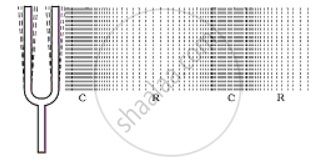Advertisements
Advertisements
Question
Distinguish between compression and rarefaction.
Solution
A longitudinal wave propagates by means of compressions and rarefactions.
When a vibrating object moves forward, it pushes and compresses the air in front of it creating a region of high pressure. This region is called a compression (C), as shown in Fig. This compression starts to move away from the vibrating object. When the vibrating object moves backwards, it creates a region of low pressure called rarefaction (R), as shown in Fig.

A vibrating object creating a series of compressions (C)
and rarefactions (R) in the medium
Compressions are the regions of high density where the particles of the medium come very close to each other and rarefactions are the regions of low density where the particles of the medium move away from each other.
APPEARS IN
RELATED QUESTIONS
Fill in the blank.
The number of times a body vibrates in one second is called its ______.
Distinguish between loudness and intensity of sound.
What type of wave is represented :
(a) by density-distance graph?
(b) by displacement-distance graph?
Name the two types of waves which can be generates in a long flexible spring (or slinky).
Explain the terms 'crests' and troughs' of a wave? What type of waves consist of crests and troughs?
Define the term wave velocity. Write its S.I. unit.
The sound of an explosion on the surface of a lake is heard by a boat man 100 m away and by a diver 100 m below the point of explosion.
(i) Who would hear the sound first: boatman or diver?
(ii) Give a reason for your answer in part (i).
(iii) If sound takes time t to reach the boatman, how much time approximately does it take to reach the diver?
Give a scientific reason.
If you were both on the moon, your friend will not be able to hear you call.
What is a longitudinal wave?
The elastic property of medium is a factor of ______ medium.
